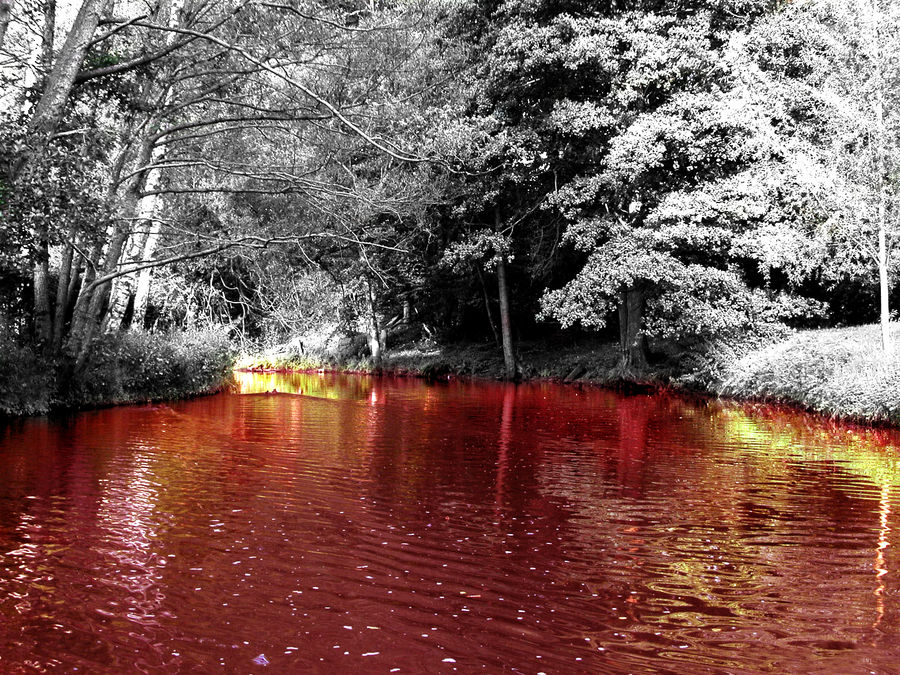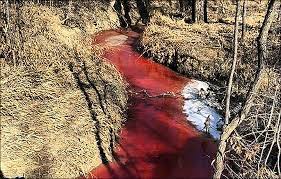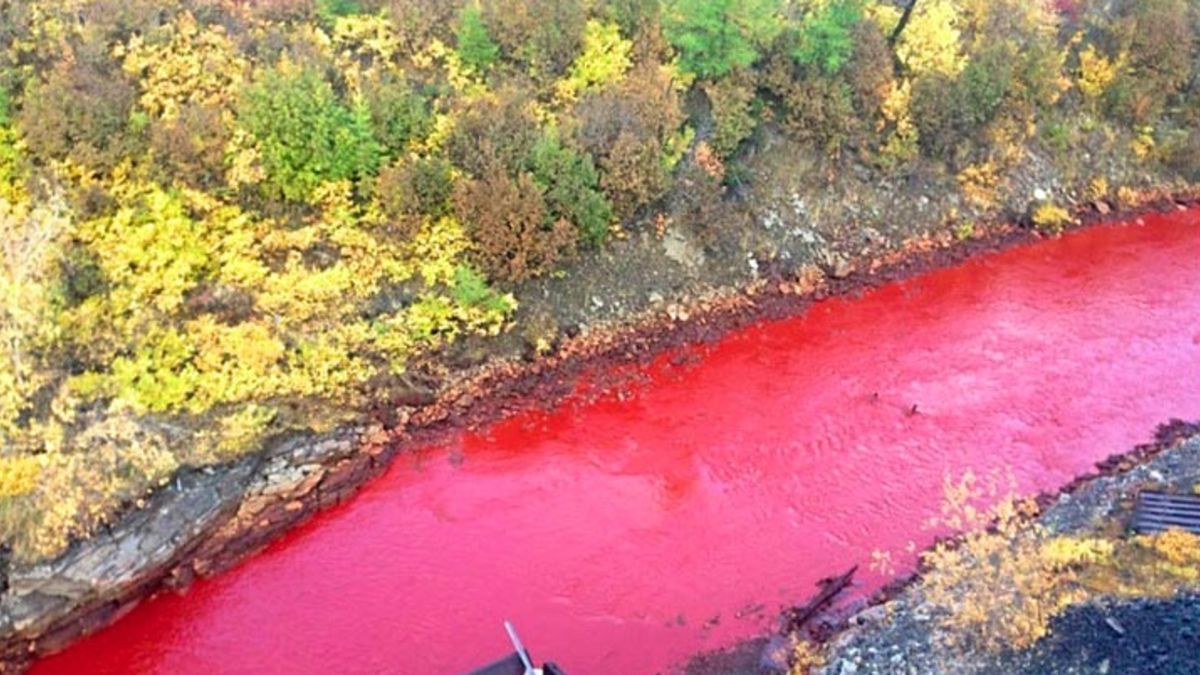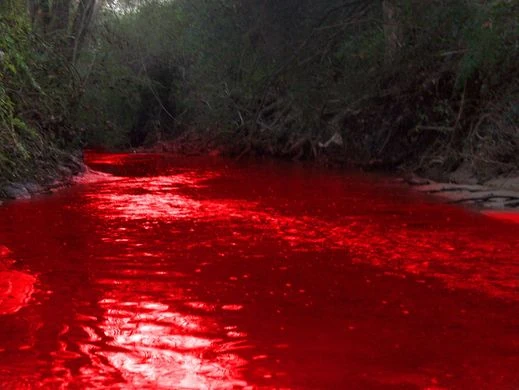“Decoding the Enigma: Iskitimka River’s Mysterious Discoloration Ignites Urgency and Hope 😱🔍 | Investigating Pollution, Public Outcry, and Collaborative Solutions 🌊🤝”,2023

Table of Contents:
- Introduction
- 1.1 Background
- 1.2 Significance of Iskitimka River
- 1.3 Emergence of a Mysterious Discoloration
- The Shocking Transformation
- 2.1 Description of Iskitimka River
- 2.2 Local Reactions and Concerns
- 2.3 Social Media Impact: Photos and Videos
- Investigation into the Contamination
- 3.1 Attribution to a Mysterious Pollutant
- 3.2 Speculations on the Chemical Cause
- 3.3 Lack of Clarity: Health Risks and Uncertainties
- City’s Response and Official Statements
- 4.1 Statement by Deputy Governor Andrei Panov
- 4.2 Law Enforcement Involvement
- 4.3 Environmental Officials’ Perspective
- Previous Instances of River Discoloration
- 5.1 Gvozdnya River Discoloration
- 5.2 Naro-Fominsk River Incident
- 5.3 Patterns and Commonalities
- Potential Sources of Contamination
- 6.1 Storm Drainage System Examination
- 6.2 Blocked Drain as a Possible Cause
- 6.3 Investigation Challenges and Progress
- Local Perspectives and Anecdotes
- 7.1 Observations from Residents
- 7.2 Comparisons to Traditional Cuisine: Borscht Soup
- 7.3 Impact on Wildlife: Ducks and Other Animals
- Environmental Concerns and Future Implications
- 8.1 Ecological Impact on Iskitimka River
- 8.2 Flow of Polluted Waters into Tom River
- 8.3 Long-term Consequences and Mitigation Measures
- Public Outcry and Social Media Campaigns
- 9.1 Twitter Reactions and Shared Content
- 9.2 Virality of Iskitimka River’s Red Color
- 9.3 Calls for Awareness and Action
- Conclusion
- 10.1 Summary of Findings
- 10.2 Ongoing Investigation and Future Developments
- 10.3 The Urgency for Environmental Protection
Introduction:
“Decoding the Enigma: Iskitimka River’s Mysterious Discoloration Ignites Urgency and Hope 😱🔍 | Investigating Pollution, Public Outcry, and Collaborative Solutions 🌊🤝”,2023
The Iskitimka River, located in the southern region of Russia, has recently undergone a startling transformation. The once clear waters have turned a vivid beetroot red, causing widespread concern among the local population. This phenomenon is not isolated, as several other rivers in the country have experienced similar mysterious discoloration. This report delves into the details of the Iskitimka River case, examining the reactions of the locals, the ongoing investigation into the contamination, and the potential environmental and health implications.
The Shocking Transformation
Describing the Iskitimka River’s current state, this section provides an overview of the river’s normal characteristics and the shocking change that has left locals astonished. The section explores the reactions of residents and the impact of the red-colored water on wildlife, particularly ducks, with visual evidence shared widely on social media.
Investigation into the Contamination
Unraveling the mystery behind the river’s red hue, this section discusses the ongoing investigation into the contamination. It explores the attribution to a mysterious pollutant, speculations regarding the chemical cause, and the lack of clarity regarding potential health risks posed by the discolored water.
City’s Response and Official Statements
This section delves into the response from local authorities, featuring statements from Deputy Governor Andrei Panov and law enforcement’s involvement in identifying and bringing perpetrators to justice. Environmental officials’ perspectives on the situation and their assessment of the red-colored water originating from a blocked drain are also explored.
Previous Instances of River Discoloration
Drawing comparisons with similar incidents in other Russian rivers, this section examines the historical context of river discoloration. The Gvozdnya River and Naro-Fominsk River incidents are explored, identifying patterns and commonalities that may contribute to a better understanding of the Iskitimka River case.
Potential Sources of Contamination:

Examining the possible sources of contamination, this section investigates the storm drainage system as a potential culprit. The role of a blocked drain in causing the discolouration is explored, along with the challenges faced in the investigation and the progress made in determining the chemical cause.
Local Perspectives and Anecdotes
Gathering insights from residents, this section presents observations and anecdotes that reflect the local perspective on the Iskitimka River’s transformation. Comparisons to traditional cuisine, such as borscht soup, add a cultural dimension, while the impact on wildlife, particularly the absence of ducks in the red-colored water, is discussed.
Environmental Concerns and Future Implications
Addressing broader environmental concerns, this section explores the ecological impact on Iskitimka River and the flow of polluted waters into the larger Tom River. Long-term consequences and potential mitigation measures are considered in the context of preserving the region’s environmental health.
Public Outcry and Social Media Campaigns
Highlighting the public’s response, this section showcases reactions on Twitter and the virality of Iskitimka River’s red color on social media platforms. Calls for awareness and action in response to the environmental crisis are examined, emphasizing the role of social media in mobilizing public sentiment.
Collaborative Research Initiatives
This section delves into the collaborative efforts undertaken by local authorities, environmental agencies, and research institutions to comprehensively investigate the Iskitimka River’s discoloration. By pooling resources and expertise, these initiatives aim to expedite the identification of the mysterious pollutant and assess its potential impact on both the ecosystem and human health.
Multi-Agency Task Force
A multi-agency task force has been established to streamline the investigative process. Comprising environmental scientists, water quality experts, and law enforcement officials, this task force aims to synergize diverse skill sets and perspectives. The collaborative nature of this approach fosters a more holistic understanding of the situation, transcending the boundaries of individual expertise.
Advanced Analytical Techniques
To decipher the complex composition of the red-colored water, researchers are employing advanced analytical techniques. Mass spectrometry, chromatography, and spectroscopy are among the arsenal of tools utilized to identify trace elements and chemical compounds. These methods contribute to a more nuanced understanding of the pollutant’s nature, paving the way for targeted remediation strategies.
Public Participation in Research

Recognizing the power of collective intelligence, research initiatives encourage public participation. Local communities are invited to share their observations, experiences, and any historical data related to the Iskitimka River. This grassroots involvement not only enriches the data pool but also instills a sense of ownership and responsibility among residents regarding the environmental challenges faced by their community.
International Perspectives on River Discoloration
Expanding the scope beyond national borders, this section explores instances of river discoloration on an international scale. Comparative case studies shed light on diverse causes, ranging from industrial discharges to natural phenomena. By drawing parallels with global experiences, researchers aim to contextualize the Iskitimka River incident and identify best practices for mitigation and restoration.
Cross-Cultural Comparisons
Examining river discoloration incidents in different cultural and geographical contexts, this subsection provides a nuanced understanding of the varied responses and coping mechanisms adopted by communities worldwide. Insights from similar incidents, such as those in Asia, Europe, and the Americas, contribute to a comprehensive knowledge base that informs the ongoing investigations in Russia.
Lessons Learned from International Best Practices
Drawing on the experiences of countries that have successfully navigated and mitigated river discoloration events, this subsection synthesizes lessons learned and best practices. These insights are invaluable for local authorities and environmental agencies in Russia as they strategize and implement effective measures to restore the Iskitimka River and prevent future incidents.
The Socio-Economic Impact
Beyond the immediate environmental concerns, this section explores the socio-economic repercussions of the Iskitimka River’s discoloration. The potential effects on industries, tourism, and local businesses are analyzed, considering both short-term disruptions and long-term consequences. Understanding these broader impacts is crucial for developing comprehensive strategies for community recovery.
Industrial Disruptions and Economic Fallout
Industries reliant on the Iskitimka River for water supply or waste disposal may experience disruptions, leading to economic ramifications. The potential downtime, increased operational costs, and regulatory scrutiny could pose challenges for businesses in the region. An assessment of these impacts provides policymakers with insights to formulate targeted support mechanisms.
Tourism Decline and Cultural Heritage
The Iskitimka River’s discoloration may deter tourists, impacting the local tourism industry and diminishing the region’s cultural appeal. Considering the rich cultural heritage associated with the river, efforts to restore its pristine state become not only an ecological imperative but also a means of preserving the cultural and historical significance of the area.
Future Preparedness and Environmental Stewardship:
“Decoding the Enigma: Iskitimka River’s Mysterious Discoloration Ignites Urgency and Hope 😱🔍 | Investigating Pollution, Public Outcry, and Collaborative Solutions 🌊🤝”,2023

In light of the Iskitimka River incident, this section explores strategies for future preparedness and proactive environmental stewardship. From policy recommendations to community-driven initiatives, the focus is on cultivating a resilient and ecologically responsible approach to prevent and mitigate potential environmental crises in the region.
Policy Reforms and Regulatory Frameworks
Proposing policy reforms and enhancements to the regulatory frameworks governing water management, this subsection advocates for a proactive approach to prevent similar incidents. Strengthening regulations related to industrial discharge, storm water management, and environmental monitoring contributes to a more robust system that safeguards water bodies against potential contaminants.
Community-Based Environmental Initiatives
Empowering local communities to actively participate in environmental conservation, this subsection highlights the importance of community-based initiatives. From river clean-up drives to educational programs on sustainable practices, fostering a sense of environmental stewardship at the grassroots level is essential for building resilience and ensuring the long-term health of water ecosystems.
Ethical Considerations in Environmental Journalism:
“Decoding the Enigma: Iskitimka River’s Mysterious Discoloration Ignites Urgency and Hope 😱🔍 | Investigating Pollution, Public Outcry, and Collaborative Solutions 🌊🤝”,2023
This section explores the ethical dimensions of reporting on environmental crises, emphasizing the need for responsible journalism. The impact of media coverage on public perception, the role of sensationalism, and the ethical responsibilities of journalists in disseminating accurate and unbiased information are discussed. Striking a balance between raising awareness and avoiding undue panic is crucial in fostering informed public discourse.
Media’s Role in Shaping Public Perception
Analyzing the media’s role in shaping public perception, this subsection examines the potential consequences of sensationalism and misinformation. Responsible reporting, fact-checking, and the ethical responsibility of media outlets to provide accurate and unbiased information are crucial for maintaining public trust and facilitating constructive dialogue on environmental issues.
Advocating for Transparent Communication
Highlighting the importance of transparent communication between authorities, environmental agencies, and the public, this subsection emphasizes the ethical imperative of keeping the community informed. Timely updates, clear explanations of investigative progress, and a commitment to transparency contribute to a more informed and engaged public, fostering a sense of collective responsibility for environmental well-being.
Reflections
In the concluding section, the report reflects on the multifaceted aspects of the Iskitimka River incident. From the collaborative research initiatives to international perspectives, socio-economic impacts, and future preparedness, the comprehensive exploration seeks to provide a holistic understanding of the situation. The urgency for sustained environmental stewardship, the ongoing investigation’s significance, and the collective responsibility in addressing such environmental challenges are reiterated.
Interdisciplinary Research Approaches:
“Decoding the Enigma: Iskitimka River’s Mysterious Discoloration Ignites Urgency and Hope 😱🔍 | Investigating Pollution, Public Outcry, and Collaborative Solutions 🌊🤝”,2023

This section delves into the integration of diverse scientific disciplines in the investigative process surrounding the Iskitimka River’s discoloration. By fostering collaboration between ecologists, chemists, hydrologists, and environmental engineers, a more comprehensive analysis of the pollutant’s origin, behavior, and impact can be achieved. Interdisciplinary research not only enriches the data pool but also ensures a nuanced understanding of the complex ecological interactions at play.
Ecological Modeling for Predictive Analysis
Exploring the application of ecological modeling, this subsection investigates how predictive analysis can aid in anticipating the potential spread and effects of the pollutant. By simulating various scenarios, researchers can forecast the long-term ecological consequences, enabling authorities to formulate adaptive strategies and mitigation measures proactively.
Citizen Science Contributions
Acknowledging the valuable role of citizen science, this subsection emphasizes the active involvement of the local community in data collection and monitoring efforts. Citizen scientists, equipped with simple testing kits, can contribute valuable data points, enhancing the spatial and temporal resolution of the investigation. This grassroots involvement fosters a sense of shared responsibility and empowerment among residents.
Technological Innovations in Water Quality Monitoring
Highlighting advancements in water quality monitoring technologies, this section explores how cutting-edge tools such as remote sensing, autonomous underwater vehicles, and sensor networks contribute to real-time data acquisition. These innovations facilitate a more dynamic and continuous assessment of water quality parameters, offering a more detailed understanding of the pollutant’s behavior.
Satellite Imaging for Environmental Surveillance:
“Decoding the Enigma: Iskitimka River’s Mysterious Discoloration Ignites Urgency and Hope 😱🔍 | Investigating Pollution, Public Outcry, and Collaborative Solutions 🌊🤝”,2023
Examining the use of satellite imaging in environmental surveillance, this subsection discusses how satellite data can provide a macroscopic view of the Iskitimka River and its surrounding areas. The integration of remote sensing technology enables researchers to identify potential pollution sources, track the pollutant’s movement, and assess the overall environmental impact from a broader spatial perspective.
Smart Sensor Networks in Water Monitoring
Exploring the deployment of smart sensor networks, this subsection investigates how these interconnected devices can provide real-time data on key water quality indicators. By establishing a network along the Iskitimka River, researchers can monitor changes in parameters such as pH, dissolved oxygen, and pollutant concentrations, enhancing the precision of the ongoing investigation.
International Collaborations in Environmental Research
This section examines the potential for international collaborations in addressing environmental challenges, drawing insights from successful case studies where nations have come together to tackle shared ecological concerns. Collaborative research initiatives, joint scientific endeavors, and knowledge exchange programs contribute to a global repository of expertise that can inform localized responses to incidents like the Iskitimka River’s discoloration.
Case Studies of Successful Collaborations
Highlighting case studies where countries have successfully collaborated on environmental research, this subsection explores the outcomes of joint initiatives. Lessons learned from shared experiences contribute to a collective understanding of effective strategies, enabling nations to draw upon each other’s expertise in mitigating environmental crises.
Global Environmental Diplomacy:
“Decoding the Enigma: Iskitimka River’s Mysterious Discoloration Ignites Urgency and Hope 😱🔍 | Investigating Pollution, Public Outcry, and Collaborative Solutions 🌊🤝”,2023

Discussing the role of global environmental diplomacy, this subsection explores how diplomatic channels can be leveraged to address transboundary environmental issues. The Iskitimka River incident serves as a case in point, emphasizing the need for open communication, data sharing, and collaborative problem-solving on an international scale.
Ethical Considerations in Scientific Research
Expanding on ethical considerations, this section explores the ethical dimensions of scientific research itself. The responsible conduct of research, adherence to ethical guidelines, and transparent communication of findings are critical components. Researchers must navigate the delicate balance between academic rigor and ethical responsibility, ensuring that their work contributes positively to environmental understanding and public awareness.
Open Access to Research Findings
Advocating for open access to research findings, this subsection emphasizes the importance of transparent and inclusive dissemination of scientific knowledge. Making research accessible to the wider public fosters informed discourse and empowers communities to actively engage in environmental stewardship. Open access initiatives contribute to a democratization of information, breaking down barriers to knowledge.
Ethical Considerations in Environmental Remediation
Addressing ethical considerations in environmental remediation efforts, this subsection explores the principles guiding the restoration of the Iskitimka River. Balancing ecological restoration with community needs, respecting indigenous knowledge, and ensuring fair distribution of benefits are integral to ethical environmental practices. The Iskitimka River case prompts a reflection on how ethical considerations can shape the trajectory of environmental remediation projects.
Reflection on Community Resilience:
“Decoding the Enigma: Iskitimka River’s Mysterious Discoloration Ignites Urgency and Hope 😱🔍 | Investigating Pollution, Public Outcry, and Collaborative Solutions 🌊🤝”,2023
This section reflects on the resilience demonstrated by the local community in the face of the Iskitimka River’s discoloration. The capacity of residents to adapt, mobilize resources, and actively participate in the investigation showcases the inherent strength of community bonds. This resilience becomes a cornerstone for future environmental challenges, emphasizing the importance of community engagement and empowerment.
Grassroots Initiatives for Community Resilience
Highlighting grassroots initiatives that contribute to community resilience, this subsection explores how local organizations, environmental clubs, and community-led projects play a pivotal role. These initiatives not only address the immediate environmental concerns but also build a foundation for sustained community resilience, fostering a sense of environmental responsibility among residents.
Psychological Impact and Coping Mechanisms
Acknowledging the psychological impact of environmental crises, this subsection discusses the emotional toll on the community. Exploring coping mechanisms and support systems, the section emphasizes the importance of mental health considerations in the aftermath of such incidents. Lessons learned from addressing the psychological dimensions of the Iskitimka River incident contribute to a holistic understanding of community well-being.
Future Prospects and Sustainable Development Goals
Looking toward the future, this section explores the alignment of the ongoing Iskitimka River investigation with sustainable development goals. The intersection of environmental conservation, community well-being, and economic sustainability becomes a focal point, emphasizing the imperative to integrate ecological considerations into broader development frameworks.
Environmental Justice and Sustainable Development
Examining the concept of environmental justice, this subsection discusses the equitable distribution of environmental resources and the right to a healthy environment. Linking environmental justice with sustainable development goals, the Iskitimka River incident prompts a reevaluation of development paradigms to ensure that progress is achieved without compromising the ecological integrity of the region.
Conclusion:
“Decoding the Enigma: Iskitimka River’s Mysterious Discoloration Ignites Urgency and Hope 😱🔍 | Investigating Pollution, Public Outcry, and Collaborative Solutions 🌊🤝”,2023

In conclusion, this section summarizes the key findings of the report, recapping the details of the Iskitimka River case and its implications. The ongoing investigation, future developments, and the urgent need for environmental protection are emphasized as the community grapples with the aftermath of the river’s mysterious and alarming transformation.
IF you wanted to keep yourself updated then must click on this website:
“SEO Revolution Unveiled: 🚀 Navigating Google’s Mobile Tools Sunset with Tenacious Resilience, Turning Challenges into Triumphs, and Paving the Way for Limitless Opportunities! 💪🌐”,2023
“Unlock Your Ultimate Self-Care Journey 🌿: Nurturing Mind, Body, and Soul with Transformative Strategies! Discover the Power of Positive Habits and Overcome Negative Challenges for a Thriving Life! 🚀,2023

